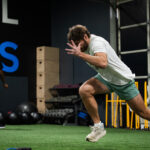Goalkeeper Performance Training for Soccer Success
Goalkeepers are the last line of defense, and their performance can make or break a match. Elite soccer performance training for goalkeepers isn’t just about reflexes and shot-stopping—it’s about agility, decision-making, and mental focus. Whether you’re diving for a penalty kick or organizing the defense, proper training prepares you to handle any situation that comes your way.
Let’s explore the key elements of goalkeeper-specific performance training and how to develop into a game-changing keeper.
What Makes a Great Goalkeeper?
Great goalkeepers are more than just shot-stoppers. They are dynamic, composed, and have exceptional physical and mental resilience.
Key traits of a top-tier goalkeeper include:
-
Quick reflexes and reaction times
-
Agility and explosive movements
-
Excellent communication skills
-
Strong decision-making under pressure
-
Good aerial ability for crosses and corners
-
Leadership and confidence to organize the defense
Training for goalkeepers must focus on improving these skills to dominate the box.
Core Components of Goalkeeper Training
1. Agility and Quick Reactions
Goalkeepers need to move quickly in any direction—whether it’s diving to save a shot or positioning themselves for a cross.
-
Lateral shuffle drills
-
Cone weaves with rapid changes of direction
-
Reactive ball drops (where the coach throws the ball at different heights)
-
High-speed lateral sprints
Agility training helps keepers change direction quickly without losing balance.
2. Shot Stopping and Diving
A goalkeeper’s primary responsibility is shot-stopping. This includes saving powerful shots and reacting to unpredictable deflections.
-
Reaction drills with low, mid, and high shots
-
Diving to the left, right, and forward
-
Shot-blocking with the body (diving with elbows and legs)
-
Saving low-driven shots (using correct body positioning)
Training with varied shot angles and intensities improves a keeper’s ability to react under pressure.
3. Aerial Ability and Crosses
Goalkeepers must control the air, whether it’s catching crosses, punching the ball, or timing a header to clear danger.
-
High-ball drills with catching and punching
-
Crosses from both sides
-
Positioning drills for timing jumps
-
Diving for crosses and smothering the ball
Practicing aerial control helps ensure the goalkeeper can handle any ball delivered into the box.
4. Distribution and Decision-Making
A great goalkeeper is also a playmaker. Proper distribution allows a team to transition from defense to offense quickly.
-
Short and long throws and punts
-
Distribution under pressure (with defenders closing in)
-
Decision-making drills (when to release the ball quickly and when to hold onto it)
The ability to distribute the ball accurately and intelligently can change the course of a match.
Sample Weekly Training Plan for Goalkeepers
Monday – Agility + Shot Stopping
-
Lateral shuffle sprints – 4 x 10 meters
-
Quick reactions with ball drop (coach drops balls randomly) – 10 reps
-
Low diving shot-stopping drills – 3 sets of 10 shots
-
High diving shot-stopping drills – 3 sets of 8 shots
Tuesday – Aerial Work + Decision Making
-
Crosses from both sides – 3 x 15
-
Catching and punching drills – 3 x 10
-
Distribution drills (throwing, punting, goal kicks) – 5 x 5 reps
-
Positioning for high balls and timing jumps
Wednesday – Mobility + Recovery
-
Dynamic stretching
-
Foam rolling
-
Light jog or swimming for active recovery
Thursday – Explosive Power + Reaction
-
Medicine ball slams – 3 x 8
-
Plyometric jumps – 4 x 5
-
Quick-reaction shot-blocking drills – 10 rounds
-
Core strengthening exercises (planks, leg raises)
Friday – Small-Sided Games + Tactical Drills
-
5v5 games with focus on goalkeeper positioning
-
1v1 situations with the keeper involved
-
Close-range shot-stopping
Saturday – Match Day or Light Recovery
Sunday – Rest
To develop as a goalkeeper, Next Level Athletics offers position-specific training programs designed to enhance shot-stopping, agility, and leadership skills.
Goalkeeper-Specific Drills You Can’t Miss
1. Reaction Drill with Ball Drops
-
Have a coach or partner drop balls from different heights and angles.
-
React and move quickly to save each shot or ball drop.
2. Cross-Facing Catch Drill
-
Crosses come from both sides—practice timing jumps, catching, and clearing the ball.
3. 1v1 Situation
-
Face off against a striker and practice shot-blocking, closing down space, and making the save.
4. High Ball Control Drill
-
Practice catching and punching crosses while staying focused on body positioning and timing.
Tips for Goalkeepers
✅ Work on your footwork
Quick, smooth movements set up every save. Start with basic footwork drills and progress to more complex scenarios.
✅ Always stay alert
Even when the ball is on the other side of the pitch, stay aware of your positioning and movement.
✅ Be vocal
Communicate with your defenders—help organize the backline and command your box.
✅ Stay composed under pressure
Great goalkeepers never panic. Trust your training and stay calm when facing intense situations.
Common Goalkeeper Training Mistakes to Avoid
❌ Not training both sides equally
Work on diving and saving shots to both your left and right equally.
❌ Forgetting mental preparation
Goalkeeping is as much mental as it is physical. Visualize success and prepare for match situations.
❌ Skipping core and leg strength
Strong legs and a stable core are essential for explosive movements and shot-stopping.
❌ Overlooking recovery
Goalkeepers need rest. Don’t train too hard without proper recovery—this can lead to burnout or injury.
Conclusion: Become the Last Line of Defense
Being a goalkeeper isn’t just about stopping shots—it’s about commanding the box, making crucial decisions, and leading your team. By focusing on soccer performance training for goalkeepers, you can improve your agility, shot-stopping, distribution, and overall presence in the game.
With the right training, you’ll be the keeper who makes the game-winning saves, controls the air, and directs the defense.


Recent Comments